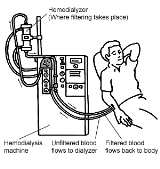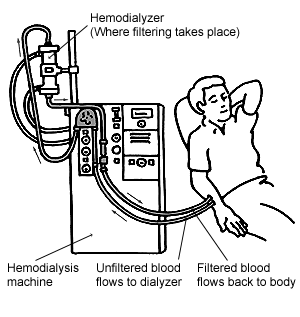
Step-by-step description of hemodialysis
Encyclopedia
Starting hemodialysis
is often a frightening experience. Hemodialysis machines are complicated and dialysis sessions often are punctuated by alarms. At the beginning of dialysis and at the end of dialysis a lot of things happen. Not knowing what it is can be anxiety provoking. The following step-by-step description of hemodialysis will hopefully clarify some things for people start dialysis and allow others to gain a better understanding of what dialysis entails.

Hemodialysis
In medicine, hemodialysis is a method for removing waste products such as creatinine and urea, as well as free water from the blood when the kidneys are in renal failure. Hemodialysis is one of three renal replacement therapies .Hemodialysis can be an outpatient or inpatient therapy...
is often a frightening experience. Hemodialysis machines are complicated and dialysis sessions often are punctuated by alarms. At the beginning of dialysis and at the end of dialysis a lot of things happen. Not knowing what it is can be anxiety provoking. The following step-by-step description of hemodialysis will hopefully clarify some things for people start dialysis and allow others to gain a better understanding of what dialysis entails.

Pre-dialysis
- Before or around the time the patient arrives for his/her scheduled session, a dialysis machine will be prepared. There are many models of dialysis machines, but typically in modern machines there will be a computer, CRTCathode ray tubeThe cathode ray tube is a vacuum tube containing an electron gun and a fluorescent screen used to view images. It has a means to accelerate and deflect the electron beam onto the fluorescent screen to create the images. The image may represent electrical waveforms , pictures , radar targets and...
, a pump, and facility for disposable tubing and filters. The filters (the actual artificial kidneys) are cylindrical, clear plastic outside with the filter material visible inside (looks like thick paper). They are perhaps 15-18 inchInchAn inch is the name of a unit of length in a number of different systems, including Imperial units, and United States customary units. There are 36 inches in a yard and 12 inches in a foot...
es long, and 2-3 inches thick. They have tubing connectors at both ends. The technician or nurse will set up plumbing on the machine in a moderately complex pattern that has been worked out to move blood through the filter, allow for saline drip (or not), allow for various other medications/chemicals to be administered. How the plumbing is set up may vary between models of machine and they types of filters. For some filters, it is necessary to clear sterilizing fluid from the filter before connecting the patient. This is done by altering the plumbing to push salineSaline (medicine)In medicine, saline is a general term referring to a sterile solution of sodium chloride in water but is only sterile when it is to be placed intravenously, otherwise, a saline solution is a salt water solution...
through the filter, and carefully checked with a type of litmus test. - The pump does not directly contact the blood or fluid in the plumbing — it works by applying pressure to the tubing, then moving that pressure point around. Think of a disk with a protrusion in it. Put this into a close fitting 270 degree enclosure. Put plastic tubing between the enclosure and the disk, entering and exiting in the 90 open degrees. Now imagine the disk turning. It will put pressure on the tubing, and the pressure point will roll around through the 270 degrees, forcing the fluid to move (see also Peristaltic pumpPeristaltic pumpA peristaltic pump, or roller pump, is a type of positive displacement pump used for pumping a variety of fluids. The fluid is contained within a flexible tube fitted inside a circular pump casing . A rotor with a number of "rollers", "shoes" or "wipers" attached to the external circumference...
). It is characteristic of dialysis machines that most of the blood out of the patients body at any given time is visible. This facilitates troubleshooting, particularly detection of clotting. - The patient arrives and is carefully weighed. Standing and sitting blood pressures are taken. Temperature is taken.
- Access is set up. For patients with a fistulaFistulaIn medicine, a fistula is an abnormal connection or passageway between two epithelium-lined organs or vessels that normally do not connect. It is generally a disease condition, but a fistula may be surgically created for therapeutic reasons.-Locations:Fistulas can develop in various parts of the...
(a surgical modification to an arm or leg vein to make it more robust, and therefore usable for high capacity blood movement required by dialysis) this means inserting two large gauge needles into the fistula. This is painful for the patient but there are various methods of numbing the entry sites before the needles are inserted — the two most common are lignocaine (lidocaine), a local anaesthetic injected under the skin, and there is also a cream called EMLA which is applied to the skin 45 minutes before the needles are inserted. Fistulas are widely considered the desirable way to get access for hemodialysis, but they take time to set up and mature (anywhere between 5 weeks to 15 weeks). For other patients, access may be via a catheterCatheterIn medicine, a catheter is a tube that can be inserted into a body cavity, duct, or vessel. Catheters thereby allow drainage, administration of fluids or gases, or access by surgical instruments. The process of inserting a catheter is catheterization...
installed to connect to large veins in the chest. Other arrangements can be made as well. - When access has been set up, the patient is then connected to the preconfigured plumbing, creating a complete loop through the pump and filter.
Dialysis
- The pump and a timer are started. Hemodialysis is underway.
- Periodically (every half hour, nominally) blood pressure is taken. As a practical matter, fluid is also removed during dialysis. Most dialysis patients are on moderate to severe fluid restrictive diets (in addition to other dietary restrictions), since kidney failure usually includes an inability to properly regulate fluid levels in the body. A session of hemodialysis may typically remove 2-5 kilogramKilogramThe kilogram or kilogramme , also known as the kilo, is the base unit of mass in the International System of Units and is defined as being equal to the mass of the International Prototype Kilogram , which is almost exactly equal to the mass of one liter of water...
s (5-10 pounds) of fluid from the patient. The amount of fluid to be removed is set by the dialysis nurse according to the patient's "estimated dry weight." This is a weight that the care staff believes represents what the patient should weigh without fluid built up because of kidney failure. Removing this much fluid can cause or exacerbate low blood pressure. Monitoring is intended to detect this before it becomes too severe. Low blood pressure can cause cramping, nausea, shakes, dizziness, lightheadedness, and unconsciousness. - During dialysis, occasionally, patients have low blood pressure and lose consciousness. Often this is temporary and passes after the head is placed down (Trendelenburg positionTrendelenburg positionIn the Trendelenburg position the body is laid flat on the back with the feet higher than the head by 15-30 degrees, in contrast to the reverse Trendelenburg position, where the body is tilted in the opposite direction. This is a standard position used in abdominal and gynecological surgery...
) for a short time.
Post-dialysis
- At the end of the prescribed time, the patient is disconnected from the plumbing - blood lines (which is removed and discarded, except perhaps for the filter, which may be sterilized and reused for the same patient at a later date). Needle wounds (in case of fistula) are bandaged with gauze, held for up to 1 hour with direct pressure to stop bleeding, and then taped in place. The process is similar to getting blood drawn, only it is lengthier, and more fluid or blood is lost.
- Temperature, standing and sitting blood pressure, and weight are all measured again. Temperature changes may indicate infection. BP discussed above. Weighing is to confirm the removal of the desired amount of fluid.
- Care staff verifies that the patient is in condition suitable for leaving. The patient must be able to stand (if previously able), maintain a reasonable blood pressure, and be coherent (if normally coherent). Different rules apply for in-patient treatment.
Post-dialysis washout
Following hemodialysis, patients may experience a syndrome called "washout". The patient feels weak, tremulous, extreme fatigue. Patients report they "are too tired, too weak to converse, hold a book or even a newspaper." It may also vary in intensity ranging from whole body aching, stiffness in joints and other flu-like symptoms including headaches, nausea and loss of appetite. The syndrome may begin toward the end of treatment or minutes following the treatment. It may last 30 minutes or 12-14 hours in a dissipating form. Patients though exhausted have difficulty falling asleep. Eating a light meal, rest and quiet help the patient cope with washout until it has 'worn away.'See also
- DialysisDialysisIn medicine, dialysis is a process for removing waste and excess water from the blood, and is primarily used to provide an artificial replacement for lost kidney function in people with renal failure...
- Home hemodialysisHome hemodialysisHome hemodialysis , is the provision of hemodialysis in the home of people with stage 5 chronic kidney disease. In the US home hemodialysis was the most common method of renal replacement therapy in the early 1970s before the introduction of the Federal ESRD program under Medicare...
- Peritoneal dialysisPeritoneal dialysisPeritoneal dialysis is a treatment for patients with severe chronic kidney disease. The process uses the patient's peritoneum in the abdomen as a membrane across which fluids and dissolved substances are exchanged from the blood...
- HemofiltrationHemofiltrationIn medicine, hemofiltration, also haemofiltration, is a renal replacement therapy similar to hemodialysis which is used almost exclusively in the intensive care setting...
- ExtracorporealExtracorporealAn extracorporeal medical procedure is a medical procedure which is performed outside the body.-Circulatory procedures:A procedure in which blood is taken from a patient's circulation to have a process applied to it before it is returned to the circulation...
therapies - Renal replacement therapyRenal replacement therapyRenal replacement therapy is a term used to encompass life-supporting treatments for renal failure.It includes:*hemodialysis,*peritoneal dialysis,*hemofiltration and*renal transplantation.These treatments will not cure chronic kidney disease...
External links
- What is dialysis? - Kidney Foundation of Canada

